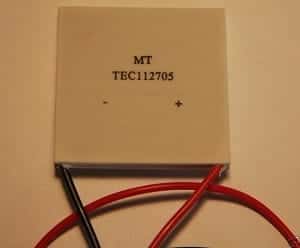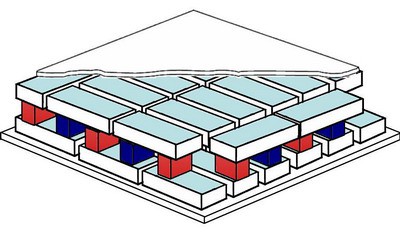Thermoelectric devices are seen very often in various appliances: small refrigerators, semiconductor chip coolers, medical chillers. The thermoelectric effect works in both directions – it can generate temperature difference when current flows, or it can induce current when the temperature difference is applied.
About thermoelectric effect
It is known for more than 100 years. Several scientists discovered this effect in one or another way. Probably you’ve heard the Peltier effect. Jean Charles Athanase Peltier discovered that if you apply an electrical current to two materials’ junction, it gets cold or hot (depending on current direction).
Thomas Johann Seebeck discovered the reverse effect when electricity is generated due to temperature differences. So this effect is Honored by his name. But for now, let’s focus on the Peltier effect and thermoelectric devices.
Peltier element
The most common element is a ceramic coated device with two wires popping out. They are made of semiconductor materials. One is N-type, and another is P. Instead of a single Junction, there are hundreds of them – simply speaking, they are connected in series, but thermally they are parallel. Multiple joints increase the surface area and so the efficiency. If you look inside the Peltier element, you will see a sandwich made of small silicon bricks electrically connected in series. The ceramic plate is used as a carrier and heat transferee.
Each pair works the same way; the heat is absorbed from one side of the plate and transferred to another. If we go deeper into working physics, we can see that when current flows, electrons in N-element are pushed against the current while holes in the P element same direction as the current. Both are moving from one side of the element, absorbing heat. The heat is carried to another junction. I hope this is enough for understanding what happens there.
And again. If we apply different temperatures to both sides of plates, we get electricity (Seebeck effect). It is not standard usage as its efficiency is very low. Some space programs have been using those as alternative energy sources.
So why thermoelectric coolers aren’t used widespread? It seems that they are beneficial in many ways, including solidness (no moving parts), failure-proof if used correctly, and are easy to control. It appears that they aren’t as efficient we would like them to be. Compressor-based systems are several times more efficient, which keeps them in the refrigerator business. Peltier elements can reach a temperature difference between the surface to about 70ºC. The more significant difference is, the worse efficiency becomes. So it is used in compact coolers, in environmentally friendly applications where efficiency isn’t the key. You’ve probably seen a USB powered cooler for soda cans – it wouldn’t be possible without thermoelectric coolers.
Peltier elements are pretty standardized devices, and you can tell some features from its ID. For instance, I have a couple of TEC1-12705 elements that can be decoded in to;
TE – thermoelectric;
C – size. C – standard; S – small;
1 – number of stages. Normally 1.
127 – the number of P-N couples inside the plate;
05 – current rating. In this case 5A.
Like all semiconductors, it is sensitive to overheating. It is advised not to power Thermoelectric element without heat-sink on the hot side. Probably you can connect it for a short time to determine which side cools and which heats.
Typical cooler application
If you are going to build a cooler, your typical setup should be as follows:
It is mandatory to put a heat-sink on a hot side of the Peltier element, which would take a transferred heat. For better transfer, put thermal paste. It is a good idea to have a temperature sensor on the heat-sink to avoid overheating. On the cold side of the plate, you can put whatever you designed – a cold plate, another heat-sink with a blower to get cool air, or whatever you need. Here also you can put a temperature sensor to keep the cold points. If hot heat-sink gets too hot, maybe you need to put a fan on it. It depends on your application and other circumstances. Next time I hope to do more physical testing of the thermoelectric cooler.






